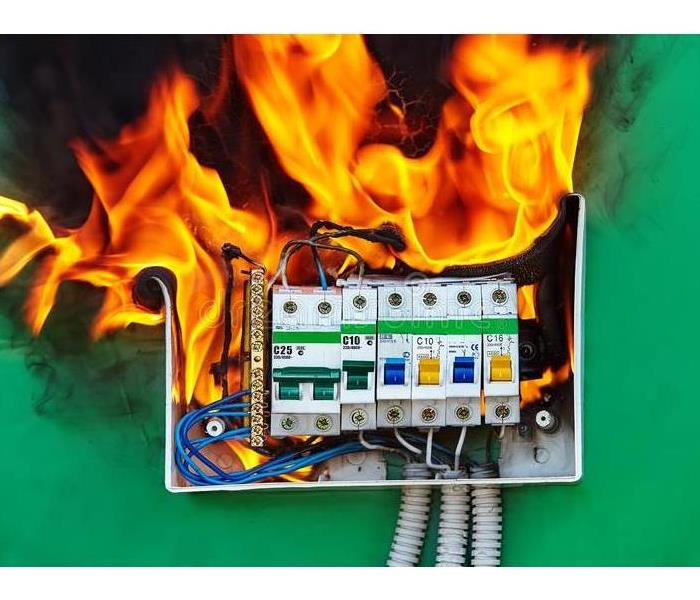Archived Fire Damage Blog Posts
Tips on extinguishing a Grease Fire
1/21/2022 (Permalink)
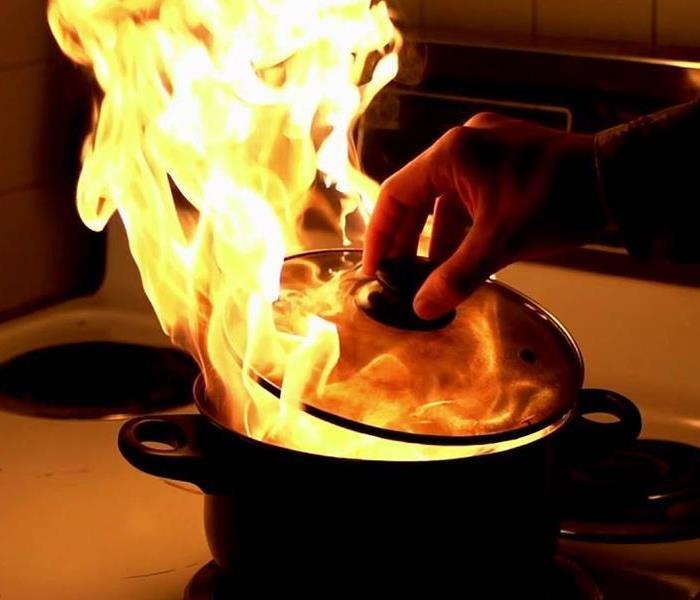 Keep a watchful eye while cooking!
Keep a watchful eye while cooking!
Cooking is the number one cause in home fires and injuries. Annually, there are 160,000 cooking fires caused by ignition of food or cooking materials.
Knowing how to smother a grease fire can help keep you, your family, and friends from getting hurt or having a severe house fire.
If A Grease Fire Starts:
- Cover the flames with a metal lid or cookie sheet. Leave the cover on until it has cooled.
- Turn off the heat source.
- If it’s small and manageable, pour baking soda or salt on it to smother the fire.
- As a last resort, spray the fire with a Class B dry chemical fire extinguisher.
- Do not try to extinguish the fire with water.
- Do not attempt to move the pot or pan outside.
DO NOT use flour, baking powder, or other cooking powders that resemble baking soda or salt. They act differently, and could make the fire worse.
If You Are Unable To Extinguish The Grease Fire:
- GET OUT!! You need to leave as soon as possible to prevent injury or loss of life
- When you leave, close the door behind you. This will help contain the fire inside.
- When you get to a safe distance from the fire, call 911 right away.
- Don’t re-enter your home until it has the “all clear” from the fire department.
Tips To Prevent Grease Fires:
- Stay in the kitchen while you’re cooking. One of the leading causes of kitchen fires is unattended cooking.
- Don’t cook if you’re exhausted or inebriated.
- Keep anything that can catch on fire away from your stovetop.
- Remove as much moisture from the food, and don’t add frozen foods to hot oil.
- Keep an eye on the temperature of your oil. If you see smoke or smell oil that means your oil is too hot. Turn off the burner and let it cool down.
- Heat the oil slowly.
- Add food gently, so there is no splashing.
- Keep a lid in arms reach in case of a fire.
- Always keep children and pets away from the stove while cooking.
Causes and Prevention Tips for Wintertime Fires
1/3/2022 (Permalink)
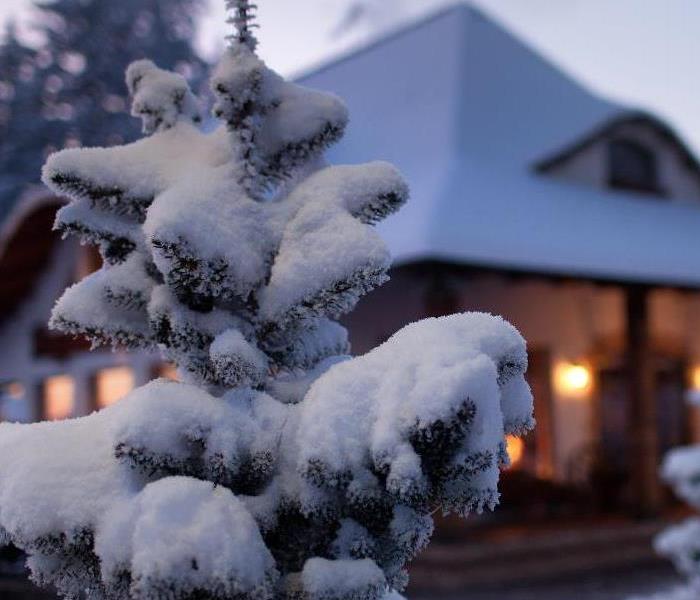 Practicing prevention is the best way to reduce the chance of a fire, however if you do experience a loss contact SERVPRO of Oak Park-River Forest
Practicing prevention is the best way to reduce the chance of a fire, however if you do experience a loss contact SERVPRO of Oak Park-River Forest
Wintertime fires are a big concern for individuals due to their statistical likelihood of occurrence.
House fires occur the most in the winter, and the increased risk makes it important to understand the causes and prevention tips in order to stay safe and fire-free this season.
Reasons for the High Rate of Winter House Fires
An Increase in Cooking
At any time of the year, cooking is found to be the leading cause of house fires in the country, but this holds especially true for the winter season. Because there are many holiday meals, occasions for baking and a general increase in cooking in the winter, it is important to exercise caution at any time the oven or stove is in use.
The Risk of Heaters
Using extra heating methods in addition to the central heating unit is quite common, but it can increase the fire risk if safety precautions are not taken. Heating is the second-highest fire cause during the winter months, typically due to unsafe fireplace use and the use of heaters that do not have automatic safety switches to prevent a fire from starting.
Candles and Decorations
While the safety of decorations is not something commonly thought of, during the winter months, it becomes gravely important. Open flames from holiday candles can quickly spread if left unattended, and electronic lights and other décor can overheat or spark if they are not well-maintained.
Preventing Winter Fires From Occurring
The many things that can contribute to a winter fire are important to note, not so that they can be avoided but so they can be completed safely. By understanding what is behind these fires and following the below prevention tips, individuals can do a better job at being fire-safe:
- Check smoke alarms once every 30 days and replace every 10 years.
- Always monitor open flames.
- Select space heaters with automatic shut-offs in case they tip over.
- Utilize a screen every time you use a fireplace.
- Draft and practice an emergency escape plan with your household.
Halloween Fire and Safety Tips
10/8/2021 (Permalink)
For kids, Halloween is often one of the most anticipated holidays of the year. Dressing up, trick-or-treating, candy, parties, hayrides and corn mazes make for great fun and amazing childhood memories. Unfortunately, Halloween has become a holiday with increasing numbers of home fires.
According to the National Fire Protection Association (NFPA), decorations were the first item ignited in an estimated average of 860 reported home structure fires every Halloween between 2009 and 2013. These fires resulted in an average of 13 million dollars in direct property damage per year. At such a high cost, it’s crucial that you take the necessary steps to help prevent a fire from igniting in your home this season.
To help you enjoy a safer holiday, follow these important Halloween safety tips from the experts at SERVPRO of Oak Park-River Forest.
HALLOWEEN SAFETY: DECORATIONS
Use these tips to help prevent your Halloween decorations from catching fire:
Pumpkin Safety
The traditional jack-o-lantern features a smiling or spooky face that’s illuminated from within by a candle. Placing candles inside a cleaned-out pumpkin is a fire hazard. In fact, any lit candle left unattended is a Halloween fire hazard. If they’re inside pumpkins, they can tip over, ignite surrounding materials and cause a fire. To stay safe, use a battery-operated candle or LED light to illuminate your festive pumpkins.
Candle Safety
Using paper bag luminaries or lining a mantle, porch stairs or windowsills with lit candles can create an eerie effect for Halloween night. However, this type of decorating is a fire hazard and poses a risk of injury to you and your guests. To help prevent a fire from decorative candles, replace them with battery-operated, no-flame candles that still provide the same spooky ambiance.
Decoration Safety
Some decorations, both inside and outside of your home, can be dangerous if left near a heat source. Straw, hay bales, corn stalks and other dry materials are flammable. To protect your home from a fire, keep these decorations away from any kind of heat source, including fireplaces, wood-burning stoves, candles and outdoor fire pits.
HALLOWEEN SAFETY: YARD MAINTENANCE
Halloween has the potential to bring plenty of residents through your lawn. To help keep trick-or-treaters and their parents safe, check that your yard is properly maintained and has adequate lighting. Before night falls, complete these tasks:
- Remove large amounts of debris, including leaves or sticks, to help reduce the risk of trips and falls.
- Check that the exterior lights are working properly, including any path lights or Halloween decorations.
- Ensure that steps and railing are secure, if necessary.
By following these tips, you can help keep everyone safe. We hope you have a happy and fun Halloween this year!
Unfortunately, accidents still happen. In the event that a fire broke out in your home, call on the experts at SERVPRO of Oak Park-River Forest. We’re available 24/7 every day of the year to get your home back to normal after a disaster. With the proper expertise, tools and innovative equipment, we can restore your home fast. Learn more about our residential fire and smoke damage removal services before the unexpected happens.
How Long is Too Long to Wait to Call SERVPRO...
9/8/2021 (Permalink)
How does SERVPRO of Oak Park-River Forest determine how to handle smoke damaged items?
Temperature, whether the fire is smoldering or blazing, as well as materials burned, each affect necessary cleanup measures differently. To make matters worse smoke particles can easily penetrate any crack and crevice. When not handled properly, particles will leave a smoke odor behind that lasts months after a fire. Proper ventilation, consistent debris removal, proper cleaning and immediate odor neutralizing efforts are critical to saving as many of your belongings as possible. However, timing is THE most crucial component of successful smoke remediation.
Are you running out of time?
The IIRC (Institute of Inspection Cleaning and Restoration Certification), a globally recognized leader in all types of remediation, identifies these time windows:
- Within minutes
Porous materials and synthetics must be immediately addressed to prevent permanent discoloration. - Within hours to days
Wooden furniture, flooring, painted walls, and clothing can become permanently stained if not addressed within hours to days of damage, and metal surfaces will at this point begin to rust, pit, and corrode, requiring refinishing or replacement. - Within weeks
Prolonged soot exposure will embed itself in the fibers and surfaces, resulting in a longer, more costly restoration with a higher likelihood of replacement.
Top 10 Fire Hazards in the Home
8/13/2021 (Permalink)
While the expert team of SERVPRO of Oak Park-River Forest is here to help if you experience a fire disaster below you will find the top 10 Fire hazards in the home.
1. Electrical Outlet Issues
The top cause of House Fires in the United States stem from issues with electrical outlets. In 2020, we are using more electronic devices than ever, and doing so we oftentimes are using too many on a single outlet. To help prevent fires be sure to not exceed your voltage on a single outlet in your home.
2. Outdated Home Wiring
Household wiring should be checked routinely to avoid circumstances that trigger major fire damage in your home. Often times wiring that is outdated, worn, or even compromised from animals can cause fire hazards in and outside your home.
3. Decorative Lights
With Halloween and Christmas right around the corner, be sure to take the proper precaution when using decorative lights including outside lights, plugs, surge protectors, extension cords, and turning off your Christmas Tree Lighting when you are not home to minimize risks.
4. Hair Products
When in a rush, do not forget to unplug your styling products. A simple mistake can result in huge damages. Make sure that your curling iron and hair dryers are off and placed on heatproof material to help reduce the chances of a fire.
5. Toasters
Proper care of your toaster can help to prevent house fires. Crumbs inside the toaster can be dangerous as they can cause sparks which leads to hazardous problems in the kitchen. Make sure to clean your toaster routinely.
6. Candles
We all love candles and aromas however we need to be cautious of placement and be sure to put them out prior to going to bed or leaving the house. Always try to place candles in holders that prevent them from falling on surfaces or tabletops.
7. Washer & Dryers
Washer and Dryers are a leading cause of fires. Routine maintenance and cleaning can help to prevent fire hazards by cleaning filters and vents as well as the outside vents of the home.
8. Smoking
If you are a smoker or someone smokes in the home, try to do so outside. Always keep lighters and matchsticks out of reach of your children as this is one of the top causes of home fires.
9. Dust in Electric Sockets
This is a recurring process as the dust piles inside electrical sockets and if not cleaned regularly may ignite and result in fire hazards.
10. Electric Blankets
While they do wonders to keep us warm in the winter, Electric Blankets can cause fires. Be sure to use an electric blanket that doesn’t have too much wear and tear. When not in use, do not fold the blankets as it helps prevent electrical issues that lead to fire hazards.
Should you experience home fire damage, let the experts at SERVPRO of Oak Park-River Forest help restore your home “Like it never even happened.” With our 24/7 emergency dispatch, we will have someone on-site quickly to access the damage and help you in your time of need.
How to Put Out An Electrical Fire
7/8/2021 (Permalink)
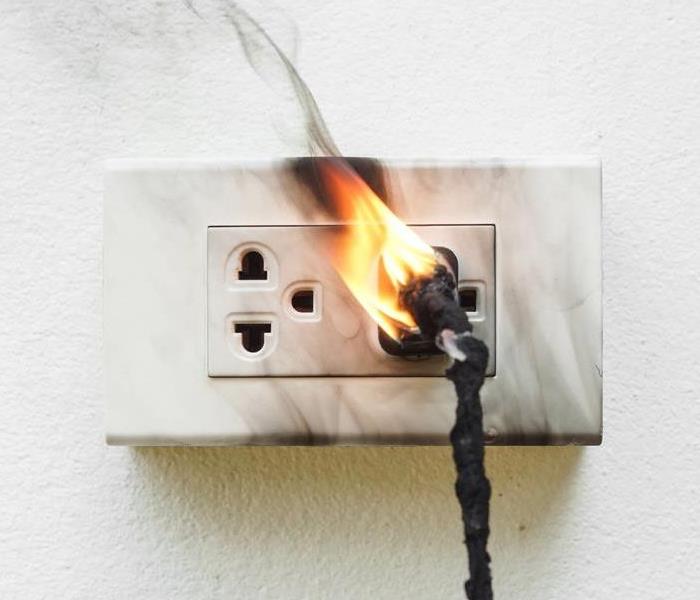 An electrical fire can be devastating! Follow these tips to make sure that you and your loved ones stay safe!
An electrical fire can be devastating! Follow these tips to make sure that you and your loved ones stay safe!
Electricity is a hidden danger to the residents in your community. Because it is so frequently used, most people tend to underestimate the risk potential and dangers that come with electrical fires.
In fact, one-third of all home structure fires stem from an electrical source, and because they tend to be difficult to identify, they are usually much more dangerous and destructive than other types of fires. Here at SERVPRO of Oak Park-River Forest, we want to share what you should do if an electrical fire starts in your home.
IF AN ELECTRICAL FIRE STARTS
1. Cut off the electricity. If the device that is causing the electrical fire is found, and you can reach the cord and outlet safely, unplug it.
2. Add sodium bicarbonate. If the fire is small, you may put it out by smothering it with baking soda.
3. Remove the oxygen source. It may also be put out by removing the oxygen source with clothing or a heavy blanket if the fire is small and it is safe to do so.
4. Don’t use water to put it out. Water is a natural conductor of electricity and if you throw water on an electrical fire, you can get shocked or electrocuted. Also, water may enable to fire to spread by conducting electricity throughout the room and potentially igniting flammable materials.
5. Check your fire extinguisher. Electrical fires are a Class C fire, which means that you will need an extinguisher that is appropriate for this type of fire. Most residential fire extinguishers are multi-purpose and labeled ABC, but it is crucial to verify this before using it on an electrical fire.
Keep These Tips Handy
In an effort to keep you and your loved ones safe, please keep these tips handy for combatting an electrical fire in the event of an emergency Knowing how to respond quickly could be the difference between a small fire and a devastating disaster. For fire restoration, call SERVPRO of Oak Park- River Forest at 708-483-8636.
Can Wood Furniture Get Restored After Fire Damage in a Home?
6/2/2021 (Permalink)
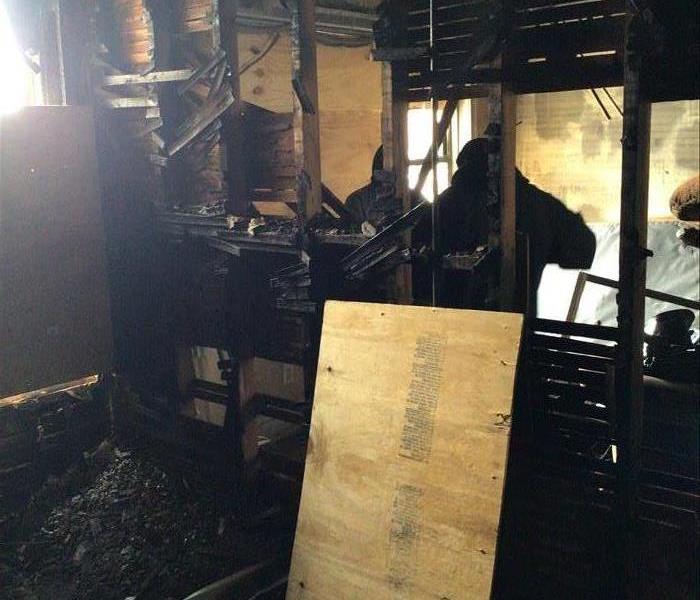 Fires are one of the most stressful events homeowners endure. SERVPRO is always available to restore your home.
Fires are one of the most stressful events homeowners endure. SERVPRO is always available to restore your home.
SERVPRO Techs Have Specialized Training to Handle Fire Damage to Both Chicagoland Properties and Contents
After a fire occurs in a home, it is not unusual to find all the room's possessions piled in the center and drenched, which is a common tactic used during fire fighting to control the blaze, and in some cases, it saves items from permanent damage.
SERVPRO technicians work hard for Chicago residents with fire damage in their homes. Not all wood furniture gets created equally, and the construction materials can determine the outcome after exposure to the high heat and water. The techs inspect each piece and look for:
- Irreparable damage to the joints from heat.
- The need for cleaning away soot and smoke damage.
- Swelling from water damage with potential to get corrected through drying.
- Deterioration in composite wood furniture.
Once inspected, the techs use their proprietary cleaning agents and methods to restore the furniture with restoration potential. Any item ruined beyond the point of repair only gets disposed of with the homeowner's approval.
SERVPRO of Oak Park-River Forest at (709) 483-8636 is the restoration services company local Chicago residents trust with their fire damage cleanup needs.
Extension Cord Safety Tips
2/2/2021 (Permalink)
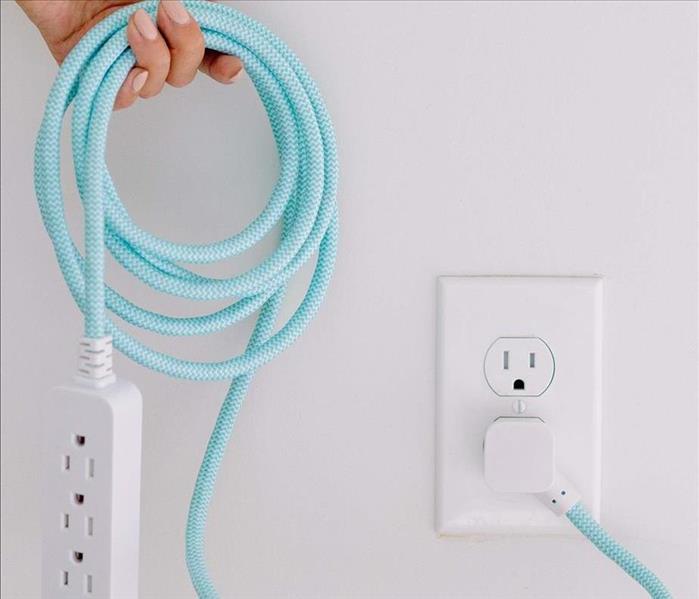 Extension cords can be a fire hazard when used improperly.
Extension cords can be a fire hazard when used improperly.
An extension cord can come in handy from time to time to help you solve a temporary power issue, however they should not be used for a long-term solution. Extension cord misuse can cause damage to your home or business. According to the Electrical Safety Foundation International (ESFI) here are some tips to keep your extension cords safe:
- Do not overload extension cords or allow them to run through water or snow on the ground.
- Do not substitute extension cords for permanent wiring.
- Do not run through walls, doorways, ceilings or floors. If cord is covered, heat cannot escape, which may result in a fire hazard.
- Do not use an extension cord for more than one appliance.
- Make sure the extension cord or temporary power strip you use is rated for the products to be plugged in.
- Never use a cord that feels hot or is damaged in any way. Touching even a single exposed strand can give you an electric shock or burn.
- Never use three-prong plugs with outlets that only have two slots for the plug. Do not cut off the ground pin to force a fit. This defeats the purpose of a three-prong plug and could lead to an electrical shock.
If you experience Fire Damage, please call SERVPRO of Oak Park-River Forest at (708) 483-8636.
Stay Warm and Safe As Temperatures Drop
2/2/2021 (Permalink)
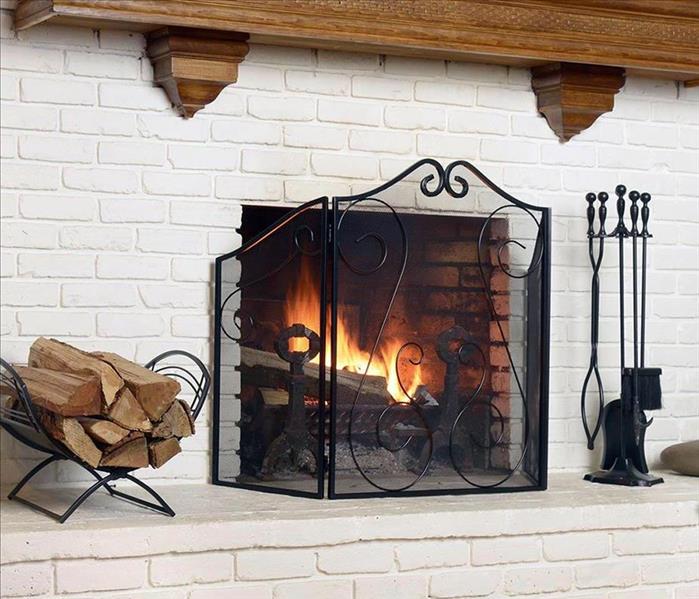 If you do experience any damage from a fire or smoke emergency, please call SERVPRO of Oak Park-River Forest at (708) 483-8636.
If you do experience any damage from a fire or smoke emergency, please call SERVPRO of Oak Park-River Forest at (708) 483-8636.
During the winter months in the Chicagoland area the outside temperatures begin to drop, and we spend more time indoors. With this being said, a warm cozy fireplace is often a place for families to gather to stay warm and cozy. Here are a few heating safety tips from the National Fire Protection Association (NFPA) to prevent heating fires from happening.
Stay warm and safe this winter!
- Keep anything that can burn at least three-feet away from heating equipment, like the furnace, fireplace, wood stove or portable space heater.
- Have a three-foot “kid-free zone” around open fires and space heaters.
- Never use your oven to heat your home.
- Have heating equipment and chimneys cleaned and inspected every year by a qualified professional.
- Remember to turn portable heaters off when leaving the room or going to bed.
- Always use the right kind of fuel, specified by the manufacturer, for fuel burning space heaters.
- Make sure the fireplace has a sturdy screen to stop sparks from flying into the room.
- Test smoke alarms at least once a month.
What You Can Do To Help Your Home After a Fire
2/1/2021 (Permalink)
The first 48 hours after a fire damage can make the difference between restoring versus replacing your belongings. SERVPRO of Oak Park-River Forest can help you mitigate your fire damage and prevent further problems. SERVPRO of Oak Park-River Forest provides quick response time, services ranging from fire, smoke and sook removal to contents claims inventory and document restoration.
Here is what you can do until SERVPRO arrives:
*Limit movement in the house to prevent soot from spreading.
*Place clean towels or old linens on rugs and traffic areas.
*Place aluminum foil or wood blocks between furniture legs and wet carpet.
*Do not was any walls or painted surfaces.
*Do not shampoo carpet or upholstery.
*Don not clean any electrical equipment.
*Do not send clothing to a dry cleaner.
Call SERVPRO of Oak Park-River Forest at 708/483-8636 for all your fire needs.
Smoke and Soot Cleanup
1/5/2021 (Permalink)
Smoke and soot is very invasive and can penetrate various cavities within your home, causing hidden damage and odor. Our smoke damage expertise and experience allows us to inspect and accurately assess the extent of the damage to develop a comprehensive plan of action.
Smoke and soot facts:
- Hot smoke migrates to cooler areas and upper levels of a structure.
- Smoke flows around plumbing systems, seeping through the holes used by pipes to go from floor to floor.
- The type of smoke may greatly affect the restoration process.
Different Types of Smoke
There are two different types of smoke–wet and dry. As a result, there are different types of soot residue after a fire. Before restoration begins, SERVPRO of Oak Park- River Forest will test the soot to determine which type of smoke damage occurred. The cleaning procedures will then be based on the information identified during pretesting. Here is some additional information:
Wet Smoke – Plastic and Rubber
- Low heat, smoldering, pungent odor, sticky, smeary. Smoke webs are more difficult to clean.
Dry Smoke – Paper and Wood
- Fast burning, high temperatures, heat rises therefore smoke rises.
Protein Fire Residue – Produced by evaporation of material rather than from a fire
- Virtually invisible, discolors paints and varnishes, extreme pungent odor.
Our Fire Damage Restoration Services
Since each smoke and fire damage situation is a little different, each one requires a unique solution tailored for the specific conditions. We have the equipment, expertise, and experience to restore your fire and smoke damage. We will also treat your family with empathy and respect and your property with care.
Have Questions about Fire, Smoke, or Soot Damage? Give us a call at (708) 483-8636.
Fall Leaf Burning
10/12/2020 (Permalink)
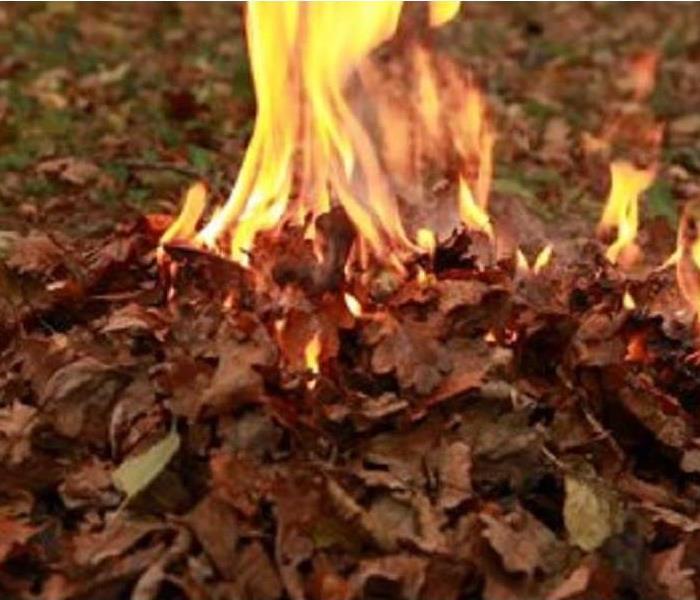 Home fire safety applies to the yard as well.
Home fire safety applies to the yard as well.
As we get further into the Fall, leaves start changing colors and falling from the trees. For many home owners this beautiful season can be overshadowed the constant need to rake their yard. It becomes a frequent task to upkeep your yard and dispose of the leaves. Some people prefer to bag the leaves and have them taken away while others burn their leaves. At SERVPRO of Oak Park-River Forest, we would like to give some simple tips to those who use the burning leaves method.
- Check to make sure it is legal in your community. Some townships have set dates for when burning leaves is acceptable or require permits.
- Create the burning pile on dirt or gravel. Avoid doing it on grass or fields.
- Consult weather forecasts on a day with high winds.
- Do not use gasoline or fire starters to start it.
- Keep the pile small and slowly add leaves as the previous ones burn to the bottom of the pile.
- Keep water source near in case of emergency and to dowse embers when finished.
Know that there are safer and less harmful ways that open burning leaves such as closed metal burn drums or putting the leaves is biodegradable bags and giving them to the city. We want to keep people safe no matter what their preferred method is.
Best Practices For Candle Use
8/17/2020 (Permalink)
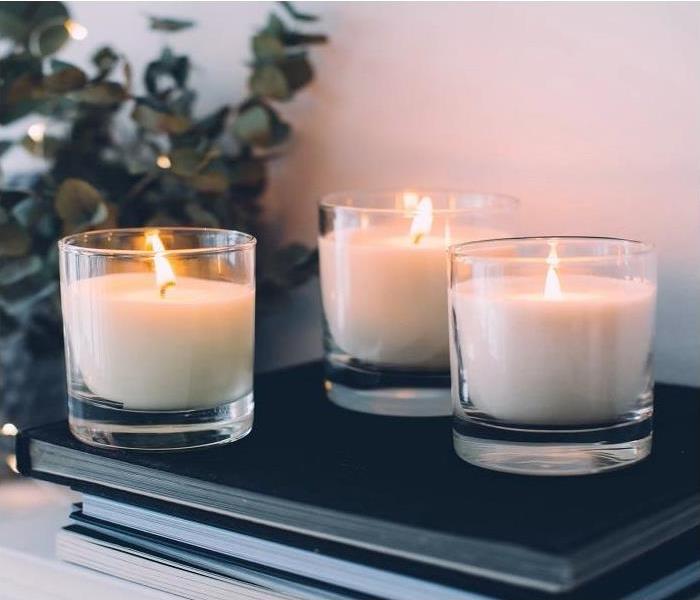 Being safe while using candles with reduce your risk of house fire.
Being safe while using candles with reduce your risk of house fire.
Candles are a popular way to embellish a room. They look and smell amazing. Unfortunately, they are also a leading cause of house fires. We would like to give you few tips for minimizing your risk of starting a candle fire in your home.
Candles Should Not Be Left Unattended
A good first rule when using candles is to not leave them unattended. If you are leaving the house or going to sleep, you should put the candle out. If you are leaving one room to spend time in another, you can bring the candle with you or put it out. Keep an eye on children and pets around candles as they can knock them over or injure themselves.
Keep Candles in Safe Locations
When finding a new spot to place a candle, keep in mind what is near it. If there are flammable liquids, curtains, or bedding near the candle, the flame or a spark has potential of igniting these materials.
Get Proper Candle Holders
It is safer to place a candle in a holder than directly onto a surface. Many candles already come in a safe glass but some require you to place them in a different container. Just be mindful that if a container not designed for the purpose of holding candles becomes too hot, it can break or melt.
Find an Alternative
The best way to prevent a candle fire is to not use a candle. There are so many alternatives for lighting to create a similar atmosphere and alternatives for creating scents. There are even flameless candles if you really love the look of a candle.
These are good tips to keep in mind when using candles to help keep your family and your home safe.
Tips for Fire Safety
7/24/2020 (Permalink)
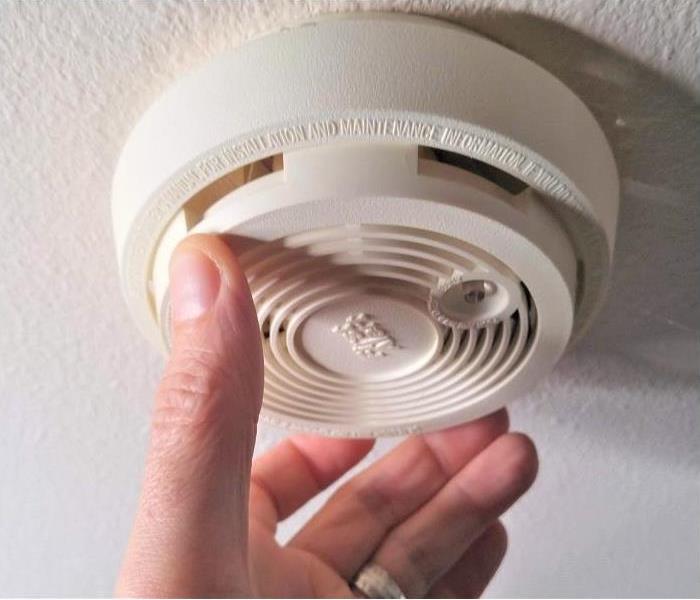 Smoke alarms are the early warning system that reduce your risk of personal injury during a fire.
Smoke alarms are the early warning system that reduce your risk of personal injury during a fire.
No one is ever prepared for a fire to happen in their home. The financial, physical, and emotional toll they leave behind can last longer than it takes to repair the home. Here are some best practices for fire prevention and safety:
Minimize the Risk
Having safe practices for cooking and heating can greatly reduce your chance of having a house fire. While cooking on a stove top or grilling, be mindful of what is near the heat source and never leave it unattended. Keep flammable things, such as paper, curtains, blankets, holiday decorations away from fireplaces and space heaters. Many homes are also making the switch to candle warmers and flame-less candles to keep open flames out of the reach of children.
Install Smoke Alarms
Did you know three out of five fire related deaths happen in homes without working smoke alarms? They are a crucial part in fire safety. You should have one on every level of your home, outside sleeping spaces, and inside bedrooms. If you or someone in your home is hearing impaired, look into getting smoke detectors that use strobe lights or bed shakers. Make sure to test them monthly and change the batteries once a year.
Create an Escape Plan
Once the smoke alarm goes off, you have one to two minutes to get out of the home so it is important to have a plan and that everyone knows what that plan is. Make sure you know all exit points of you home and try to have two ways to get out of a room. Make sure windows and door open easily and are not blocked. Designate a location away from the home to use as a meeting place in case you get separated. The most important thing is to practice this plan!
Fires are a frightening experience but there are things you can do to lower the chance of one happening and steps you can take to keep you and your family safe in case of does.
Smoke and Soot Damage
2/6/2020 (Permalink)
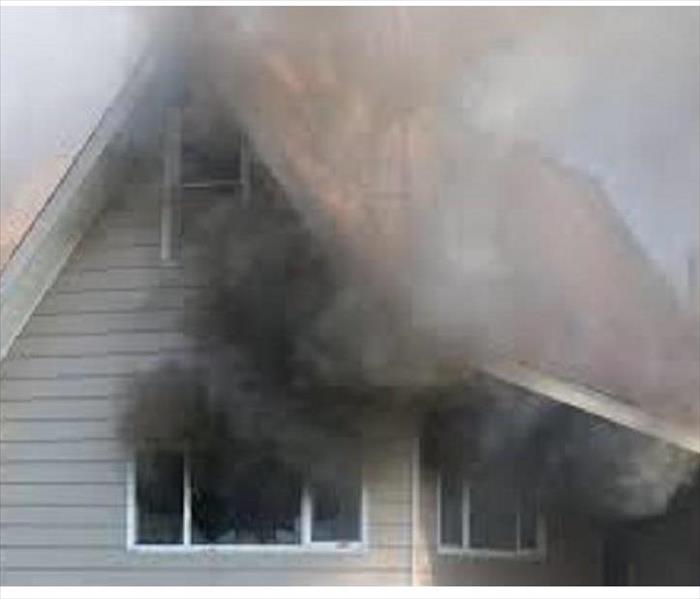 Do not let smoke damage your property.
Do not let smoke damage your property.
Smoke and Soot: The Damaging After effects of a Fire
The smallest of fires, even it isn’t at your Chicago, IL, business or home can lead to smoke damage and soot damage. Although the flames may be gone, the high acidic levels of smoke and soot can penetrate into materials and leave long-lasting effects.
Rapid Damage
Within minutes of a fire, smoke and soot are already beginning to damage your property. As soon as the fire is out and everyone is safe, making preparations for smoke cleaning and restoration are keys to getting your business back to normal. If left unchecked, the damage timeline can be extensive.
- During the first few minutes, walls, plastics and porous materials will become stained.
- Within hours, the acidic properties of soot and smoke can begin to affect metals, grout and other materials.
- After a few days, stains can become permanent corrosion and rust can begin forming. Porous materials, such as flooring and upholstery, will likely need to be replaced.
- As weeks go by, without proper cleaning, it can result in the loss of furniture, electronics and other supplies, as well as require more extensive repairs to walls, flooring, ceilings and other structural materials.
The Cleanup
Luckily, staying on the ball and contacting a fire restoration specialist can keep smoke damage from becoming permanent. They will do an assessment of the damage and work with you to get your business back up and running as quickly as possible. After the assessment, a professional will have the tools and expertise to begin the cleanup process.
While not everything may be salvageable, the right cleaning process can eliminate the smoke odors. The pros use various methods for cleaning, which will depend on the item, including dry, wet, spray, foam, abrasive and immersion. These professional methods can possibly save electronics, furniture, documents and more.
Instead of dealing with a fire’s aftermath alone, count on a professional to guide you through the process. They can help reduce the lingering effects of smoke damage, making it seem “Like it never even happened.”
Importance of Smoke Detectors in Your House
1/30/2020 (Permalink)
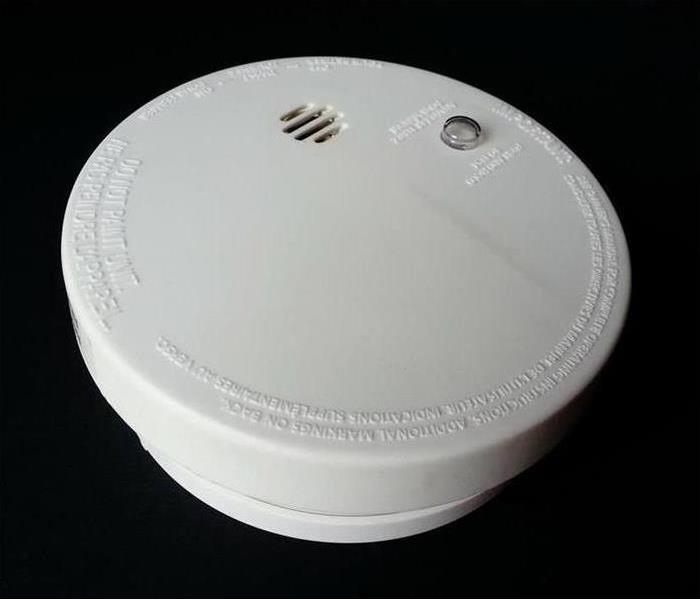 Check your smoke detector monthly.
Check your smoke detector monthly.
Smoke alarms save lives when properly installed and maintained, according to the National Fire Protection Association (NFPA). If there is a fire in your home, smoke spreads fast and you need smoke alarms to give you time to get out. We here at SERVPRO want to make sure you stay safe.
Here is what you need to know:
- A closed door may slow the spread of smoke, heat and fire. Install smoke alarms in every sleeping room and outside each separate sleeping area. Install alarms on every level of the home.
- Smoke alarms should be interconnected. When one sounds, they all sound.
- Large homes may need extra smoke alarms.
- Test your smoke alarms at least once a month. Press the test button to be sure the alarm is working.
- When a smoke alarm sounds, get outside and stay outside.
- Replace all smoke alarms in your home every 10 years.
Source: https://www.nfpa.org/Public-Education/Staying-safe/Safety-equipment/Smoke-alarms
How to Property Inspect Your Fire Extinguisher
1/28/2019 (Permalink)
Home Safety: How to Inspect a Fire Extinguisher
When was the last time you took time to check the fire extinguisher that sits under your kitchen sink? Or the one hanging from a dusty hook in your garage? If you’re struggling to remember, it’s time to check it. Like any other piece of safety equipment, a home fire extinguisher should be inspected regularly to ensure it’s in proper working condition. A fire extinguisher in good working condition is your first line of defense when a home fire erupts.
Ideally, you should inspect your portable home fire extinguishers every month.
Tips for Performing a Monthly Fire Extinguisher Check
Check the label or tag.
Every fire extinguisher, whether disposable or rechargeable, has a manufacturer’s label or tag. Read the tag and follow the manufacturer’s recommended maintenance suggestions.
Check the tamper seal.
If the tamper seal has been broken or is cracked, a disposable fire extinguisher needs to be replaced. If it’s rechargeable, it needs to be serviced professionally. Check the locking or pull pin as well to make sure it’s in the correct position. If the pin missing, the fire extinguisher needs to be inspected or serviced by a professional.
Inspect for physical damage.
Physically inspect the fire extinguisher for obvious damage. This may include but is not limited to dents, corrosion, cracks and obvious leakage. If a fire extinguisher has leakage, it’s no longer under full pressure and may not work properly when you need it most. Check the fire extinguisher nozzle as well, to ensure it’s not clogged by grime, dust, bugs or leakage from the unit itself.
Check the pressure gauge.
Check that the pressure gauge needle indicates the fire extinguisher pressure is in the optimum operating range. Often the correct pressure range will be designated by green on the gauge.
Is the fire extinguisher full?
During your monthly check, lift the fire extinguisher and determine if it still feels full. If there has been a leak, it will feel light, and it won’t have the right amount of pressure to work correctly.
Shake it.
If you have a dry chemical fire extinguisher, it should be shaken once a month during your inspection. This helps prevent the chemical dousing agent from solidifying at the bottom of the unit.
Write inspection date on tag.
Keep track of every inspection date by writing it on the fire extinguisher tag.
Ensure easy access to your fire extinguisher.
Fire extinguishers should always be easy to access if there is an emergency. You don’t want to have to search for it once a fire breaks out. Don’t block fire extinguishers with furniture, boxes or any other items. Everyone who lives in the household should know where the closest fire extinguisher is located and how to use it in case of an emergency.
In the event of a fire emergency, first make sure to get people safely away, then call 911. A home fire extinguisher can be used to put out or control small fires, but it’s still safest to call professional fire fighters before you attempt to control a fire on your own. If you need professional fire, smoke and water damage cleanup and remediation after a fire, call the experts at SERVPRO of Oak Park-River Forest.
Prevent a Clothes Dryer Fire
1/28/2019 (Permalink)
 This appliance is very important in every day life but can also be very dangerous if not inspected regularly.
This appliance is very important in every day life but can also be very dangerous if not inspected regularly.
The following are ways to prevent a clothes dryer fire in your home:
- Inspect your outdoor vent. Check to make sure that your outdoor vent flap is not covered by snow or debris.
- Do not dry items that have been stained with volatile chemicals. Wash clothing stained with flammable chemicals more than once and do not use the dryer to dry these items, opting for a clothes line dryer.
- Don’t leave your dryer unattended. If you need to leave your home, turn off the dryer during the laundry cycle.
- Install with care. Follow the manufacturer’s instructions when installing the vent pipe. Use a short, straight pipe that is an adequate distance from the wall. Reducing the bends in the dryer vent pipe creates fewer opportunities for lint to gather. Invest in a dryer vent fan if you have to vent your dryer over a long distance. Dryer vent fans increase the airflow through the duct every time you turn on your dryer forcing debris out.
- Remove combustibles. Cleaning supplies and other flammable liquids should not be kept near the dryer. In addition, sweep out dust in the areas around and underneath your dryer regularly.
- Use a metal dryer duct. Metal ducts are better than foil or plastic ducts for two key reasons. First, unlike foil or plastic ducts, metal ducts do not sag. This is important because sagging ducts contributes to lint build up at low points. Second, metal ducts are more likely to contain any fires that would start.
- Read clothing tags and labels. Always use caution when you are drying bath mats, padded bras, and bibs because they may contain rubber that should not be exposed to hot temperatures. Also, if the label instructs you to tumble dry an item, follow the advice and do not dry at hotter temperatures.
- After each dryer use, check your clothes. If your clothes do not feel dry or are extra hot after a normal drying cycle, then this may indicate that something is wrong. Before using the dryer again, check for a plugged vent and clean out any lint.
- Clean out the lint. Clean out the lint trap after each use and once a year hire a professional to clean out the vent pipes.
Dryers are the cause of many home fires. Be sure to check you dryer routinely in order to prevent possible fire.
Home Fire Safety
1/24/2019 (Permalink)
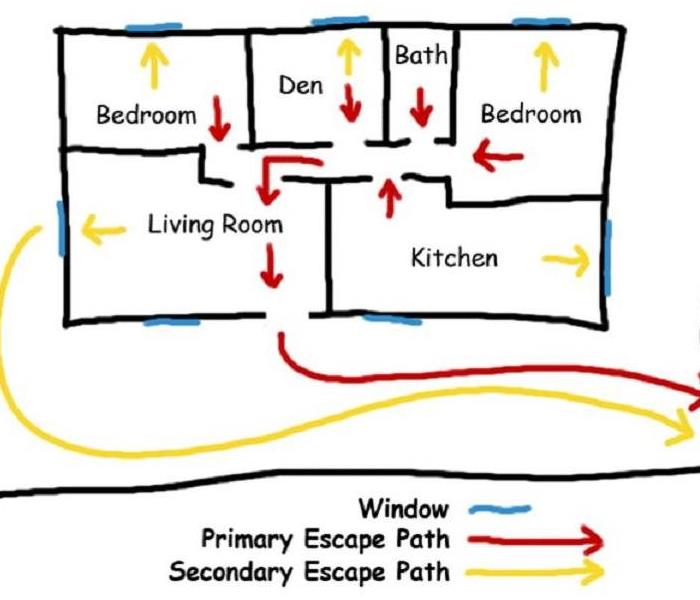 Have an escape plan.
Have an escape plan.
The American Red Cross states that you may have as little as two minutes to escape a home fire. During a fire, early warnings from a working smoke alarms and a prepared fire escape plan can save your and your families lives.
Top Tips for Fire Safety
*Install smoke alarms on every level in your home, inside bedrooms and outside sleeping areas.
*Test smoke alarms every month. Make sure to change the batteries if they are not working.
*Make a fire escape plan with your family and practice it.
*If a fire occurs in your home, get out of the home and call for help. Never go back into a burning home.
SERVPRO of Oak Park-River Forest is there for you with any fire mitigation needs from clean up to content storage.
Thanksgiving Safety
11/19/2018 (Permalink)
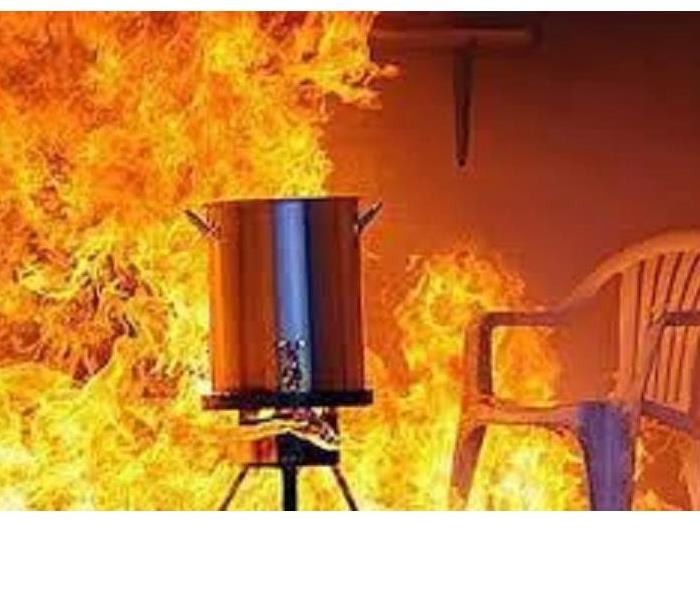 Deep fryer caught on fire.
Deep fryer caught on fire.
For most, the kitchen is the heart of the home, especially during the holidays. From testing family recipes to decorating cakes and cookies, everyone enjoys being part of the preparations.
So keeping fire safety top of mind in the kitchen during this joyous but hectic time is important, especially when there’s a lot of activity and people at home. As you start preparing your holiday schedule and organizing that large family feast, remember, by following a few simple safety tips you can enjoy time with your loved ones and keep yourself and your family safer from fire.
Thanksgiving by the numbers
- Thanksgiving is the peak day for home cooking fires, followed by Christmas Day, Christmas Eve, and the day before Thanksgiving.
- In 2016, U.S. fire departments responded to an estimated 1,570 home cooking fires on Thanksgiving, the peak day for such fires.
- Unattended cooking was by far the leading contributing factor in cooking fires and fire deaths.
- Cooking equipment was involved in almost half of all reported home fires and home fire injuries, and it is the second leading cause of home fire deaths.
Safety tips
- Stay in the kitchen when you are cooking on the stovetop so you can keep an eye on the food.
- Stay in the home when cooking your turkey and check on it frequently.
- Keep children away from the stove. The stove will be hot and kids should stay 3 feet away.
- Make sure kids stay away from hot food and liquids. The steam or splash from vegetables, gravy or coffee could cause serious burns.
- Keep the floor clear so you don’t trip over kids, toys, pocketbooks or bags.
- Keep knives out of the reach of children.
- Be sure electric cords from an electric knife, coffee maker, plate warmer or mixer are not dangling off the counter within easy reach of a child.
- Keep matches and utility lighters out of the reach of children — up high in a locked cabinet.
- Never leave children alone in room with a lit candle.
- Make sure your smoke alarms are working. Test them by pushing the test button.
Oak Park - River Forest Smoke and Soot Cleanup
6/5/2018 (Permalink)
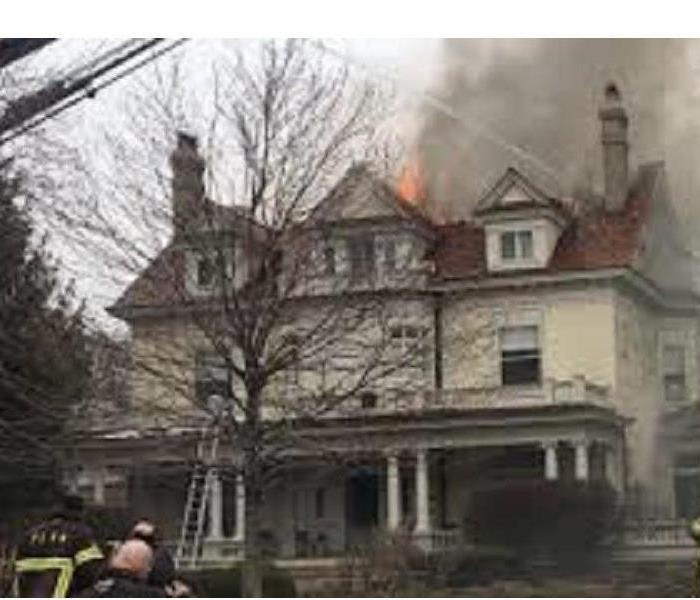 Smoke and Soot Damage Can Cause a Pervasive Odor in Your ome.
Smoke and Soot Damage Can Cause a Pervasive Odor in Your ome.
Smoke and soot is very invasive and can penetrate various cavities within your home, causing hidden damage and odor. Our smoke damage expertise and experience allows us to inspect and accurately assess the extent of the damage to develop a comprehensive plan of action.
Smoke and soot facts:
- Hot smoke migrates to cooler areas and upper levels of a structure.
- Smoke flows around plumbing systems, seeping through the holes used by pipes to go from floor to floor.
- The type of smoke may greatly affect the restoration process.
Different Types of Smoke
There are two different types of smoke–wet and dry. As a result, there are different types of soot residue after a fire. Before restoration begins, SERVPRO of Oak Park-River Forest will test the soot to determine which type of smoke damage occurred. The cleaning procedures will then be based on the information identified during pretesting. Here is some additional information:
Wet Smoke – Plastic and Rubber
- Low heat, smoldering, pungent odor, sticky, smeary. Smoke webs are more difficult to clean.
Dry Smoke – Paper and Wood
- Fast burning, high temperatures, heat rises therefore smoke rises.
Protein Fire Residue – Produced by evaporation of material rather than from a fire
- Virtually invisible, discolors paints and varnishes, extreme pungent odor.
Our Fire Damage Restoration Services
Since each smoke and fire damage situation is a little different, each one requires a unique solution tailored for the specific conditions. We have the equipment, expertise, and experience to restore your fire and smoke damage. We will also treat your family with empathy and respect and your property with care.
Have Questions about Fire, Smoke, or Soot Damage?
Call Us Today – 708-483-8636





 24/7 Emergency Service
24/7 Emergency Service



